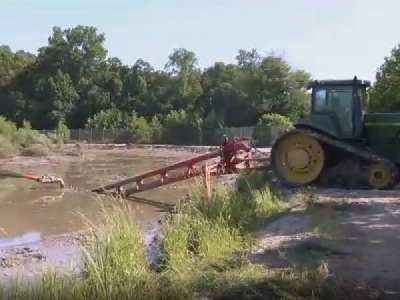
Posted on July 17, 2018
Missouri American Water uses Shoal Creek as it’s water source, treating what it pulls from the creek to remove dirt, which ends up in lagoons.
Right now crews are cleaning out thirty thousand cubic yards of it. It’s a massive operation and the water waste is actually being put to work.
South Joplin residents have been wondering why a steady stream of trucks keeps coming and going on Glendale drive. The answer is at the Missouri American Water intake plant. There, a giant tube pours sludge into Hodges Farms and Dredging trucks. A company hired to clean out the water company’s lagoons.
Jeff Hodges said, “We’re running about six thousand gallon a load probably carrying about one and half to two dry tons per load.”
The sludge is actually residual dirt cleaned from the water of Shoal creek that’s eventually filtered by Missouri American Water for drinking.
Missouri American Water’s Operations Superintendent Ray Elliott explained the current operation. “We’ve got two lagoons to clean and there’s geo-tubes which are, if you will, kind of like giant tea bags that they pump residuals in, dewater, they dry and we’re having those removed from a previous dredging.”
It’s simply a dryer version of the sludge. At the lagoon, the crew adds some water to the sludge. They’ve already removed two feet and will go down ten feet below the surface. Hodges said, “Cause its settled out in the bottom so we’re having to recirculate it, put it in heavy slurry and we’re hauling out the slurry and land applying it.”
They’re injecting two dry tons per acre of the residual into the farm property for free. But it’s a value of two hundred dollars an acre when it compares to fertilizer.
Elliott said, “With all the mining that was here in Joplin in the past, it’s nice to know we’re not contributing or starting a new problem. This is really nice for us to apply it to the farmer’s fields and help them out too.”
Six trucks each make ten round trips every day, delivering sludge to a farm field where a vacuum moves it to the application truck.
Hodges, a farmer himself, said the purple blades of grass in a field near the Camp Mintahama, mean this soil needs phosphates.
Hodges explained, “This stuff we’re hauling out right here is really high in phosphate. And there’s some organic nitrogen and lime in it and it’s just a very good beneficial, reuse, fertilizer.”
The first lagoon has about fifteen thousand cubic yards to remove. A second lagoon about half that. Each geo-tube holds about a thousand cubic yards and there are five to be removed. The work will take about two months to complete and will cost about four hundred thousand dollars.
Source: KOAM





